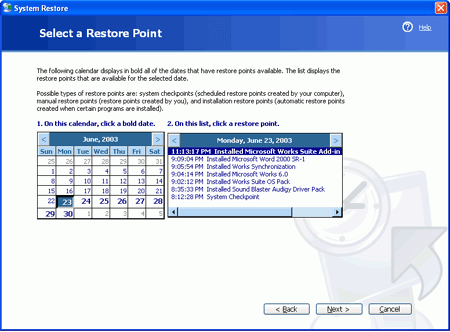Assuming you can boot into
safe mode, the first thing you should attempt to do is perform a virus and
spyware scan of your system if you have the relevant utilities such as recently
updated anti-virus software and
Ad-Aware or Spybot S&D
for spyware scans. If anything was found and eliminated in
either scan, attempt to restart Windows XP normally.
If this does not help, boot
back into safe mode. The next step is to use the built in system restore utility
to hopefully return Windows XP to working order. When run in safe mode, you can
access all recent restore points created by the system restore utility. This
gives you more flexibility than the 'last known good configuration' command in
the boot menu which only restores the most recent one.
To use the system restore
utility, go to 'start\all programs\accessories\system tools\system
restore.'

The utility reserves hard disk
space and creates a restore point each time you install or remove software. If
you are fairly sure you know what you installed that might have caused the
problem. Restore the point created at that date. Note that any software
installed since then will stop functioning, as links created to it in the
registry will be removed. Otherwise, restore your system to the most recent
point created before you started having BSOD troubles. If the first one does not
succeed in curing the problem, try the next most recent, etc.
If system restore has been
disabled on your system, or if the utility did not fix your problem, it's time
to try more specific cures.
Did you install new software
or device drivers before the problem occurred? If so, you need to disable them
as they are likely the culprits. Drivers need to be disabled or rolled back, and
software needs to be uninstalled or be stopped from running
automatically.

